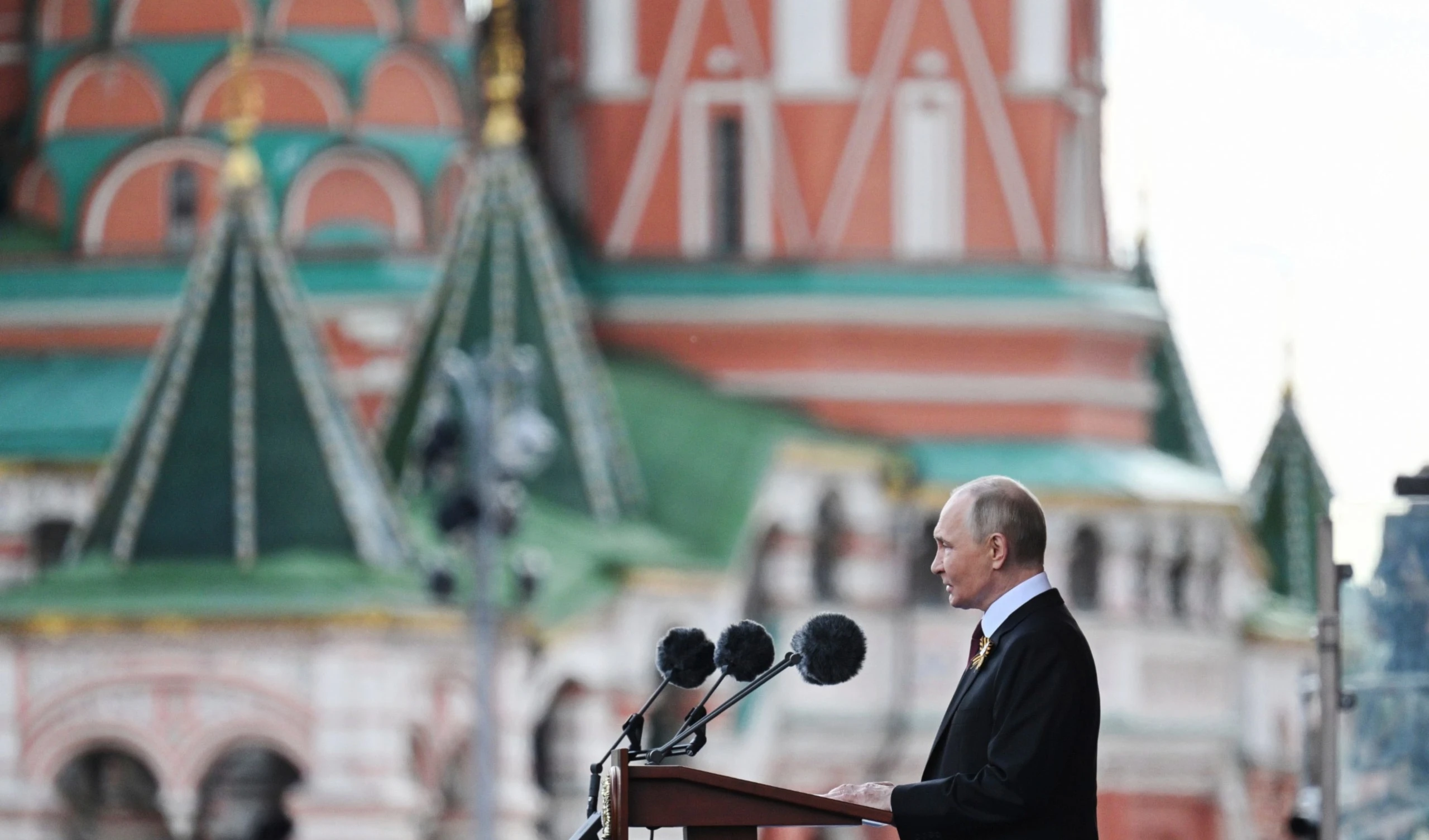Russian Burevestnik nuclear-powered cruise missile final test complete
Putin announced a final test of the nuclear-powered Burevestnik missile. Find out why this weapon’s endurance, unpredictable flight profile, and global reach pose new strategic challenges for Western defense planning.
-

In this image made from video provided by the Russian Presidential Press Office on Sunday, October 26, 2025, Russian President Vladimir Putin, center, and Russian Chief of General Staff General Valery Gerasimov arrive to visit one of the command posts of the Joint Group of Forces. (Russian Presidential Press Office via AP)
Russian President Vladimir Putin announced a successful final test of the Burevestnik, a new nuclear-powered cruise missile, pointing the "unique" nuclear-capable weapon with a range of up to 14,000 kilometers.
"The decisive tests are now complete," Putin, who is waging an offensive in neighboring Ukraine, said in a video released by the Kremlin during a meeting with military officials.
Additionally, the Russian president ordered the "infrastructure to put this weapon into service in the Russian armed forces."
Putin underlined that the missile is a "unique creation that no one else in the world possesses", adding that the nuclear-powered system has "unlimited range." During the last test on October 21, the missile spent "about 15 hours" flying 14,000 km, Chief of the General Staff of the Armed Forces of the Russian Federation Valery Gerasimov stated.
Gerasimov said that 14,000 km was not the upper limit for the weapon.
"The technical characteristics of the Burevestnik allow it to be used with guaranteed precision against highly protected sites located at any distance," he said.
The 9M730 Burevestnik, meaning “storm petrel” in Russian, is a ground-launched, low-altitude cruise missile designed to carry a nuclear payload and powered by a nuclear propulsion system. In NATO terminology, it is identified as the “SSC-X-9 Skyfall”.
Strategic reach and power projection
Russia’s declaration that Burevestnik has effectively no range ceiling and a demonstrated endurance measured in hours rather than minutes alters baseline assumptions about how Moscow can project its military might. Unlike conventional cruise missiles, which are constrained by engine fuel and typically force a trade-off between range and speed, a nuclear-powered cruise missile can be launched from well inside Russian territory and loiter or transit for many hours before committing to a strike.
That erases the geographic buffers that have limited reach, complicates defense planning, and makes strike-paths and the task of identifying which asset is being targeted far more opaque due to prolonged, unpredictable flight profiles.
For Western planners, the implication means defended-area models premised on predictable transit windows and fuel-limited timelines must now account for threats that can emerge from far greater standoff distances and remain on station for prolonged intervals. The practical effect is not only military; it is political and diplomatic. Moscow gains another on-demand strategic option it can signal, posture with, and threaten without deploying the full suite of forward assets that signal intent.
Read more: Putin oversees ICBM, cruise missile tests in strategic nuclear drill
Burevestnik specifications
Burevestnik (9M730)
- Length ≈ 12 meters.
- Warhead type: Thermonuclear (nuclear‐capable).
- Declared range: Effectively “unlimited” owing to nuclear propulsion.
- Propulsion: Nuclear reactor (nuclear power unit) + solid‐fuel booster.
- Russian MoD says this missile can loiter, transit for long durations, and transit a circuitous route to avoid defenses.
- Relation to Kh-101/102: According to Russian sources, the missile’s dimensions are “comparable to the Kh-101,” but the operational range is “orders of magnitude greater”.
Kh-101/102
- Nuclear-capable, Kh-102, has a nuclear payload of ≈ 250-kiloton, though some reports suggest it could be larger.
- Stealth Shaping: The missile has a unique, flat-sided shape that is roughly triangular in cross-section, which helps reduce its radar cross-section.
- Radar-Absorbing Materials: It is constructed with materials that absorb radar waves, making it more difficult for radar systems to detect.
- Flight Profile: The missile is designed to fly at low altitudes, hugging the terrain to avoid detection by radar systems.
- Enhanced Survivability: Upgraded versions are equipped with decoy dispensers and an electronic warfare system to protect against anti-aircraft missiles.
Read more: China, Russia advance in hypersonic missiles as US lags behind
Penetration, survivability, the missile-defense problem
Burevestnik’s operational value lies less in raw speed than in endurance, unpredictability, and approach flexibility. Long loiter times and the ability to vary approach vectors force defenders to broaden sensor coverage, extend tracking windows, and commit interceptors over wider areas for longer periods.
That imposes operational strain on integrated air and missile defense architectures and increases the cost of defending critical sites. Compared with Western tactical and strategic cruise missiles, Tomahawk, LRASM, and JASSM family, which are constrained by fuel and typically operate within known mission timelines, a nuclear-powered missile can present a far more persistent, ambiguous target.
Burevestnik is not a standalone novelty but is an additional instrument within Russia’s multi-vector nuclear toolkit. Fielded alongside Sarmat ICBMs, Avangard hypersonic glide vehicles, and the Poseidon underwater system, a nuclear-powered cruise missile expands the menu of coercive options available to Moscow.
Moreover, this provides Russia with a low-profile mechanism to threaten high-value targets, hardened military facilities, critical nodes of infrastructure, and command and control centers, while maintaining plausible operational ambiguity.
Read more: Russian missiles outsmart US Patriot defenses in Ukraine: FT
Western responses, cost imposition, escalation calculus
The most immediate consequence for Russia’s opponents is a shifting cost-imposition problem. Western responses fall into three broad categories: enhance persistent surveillance and tracking, harden and disperse high-value assets, and deny or target launch and support infrastructure. Each path carries important political, financial, and escalation costs.
Persistent Intelligence, Surveillance, and Reconnaissance (ISR) expansion, more maritime patrols, extended Arctic monitoring, and allied sensor sharing impose operational burdens and budgetary pressures on already suffering economies. Hardening and dispersal of infrastructure reduces vulnerability but degrades operational efficiency. Pre-emptive or counter-force targeting of launch sites carries acute escalation risks, especially when nuclear technology and reactors are involved.
Moscow benefits from this dynamic: by changing the defensive calculus, it forces adversaries into costly, politically fraught choices, enhancing Russia’s leverage without immediate kinetic action.
Putin’s announcement that the Burevestnik has completed decisive tests and that infrastructure will be prepared for service is more than a technical milestone; it is an assertion of a new operational posture. Whether Russia deploys the system widely or keeps it for specialized missions, its proven long-range endurance and claimed precision against fortified targets make it a lasting addition to Russia’s strategic arsenal.
Read more: Russia warns it can easily intercept US Tomahawk missiles in Ukraine

 6 Min Read
6 Min Read











